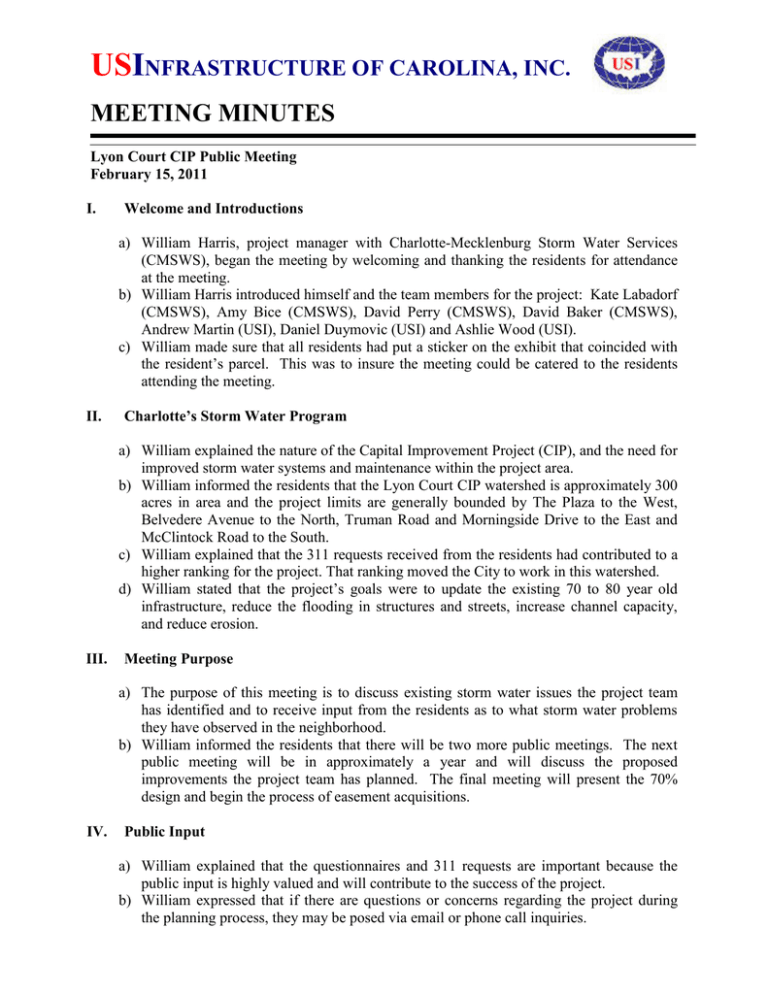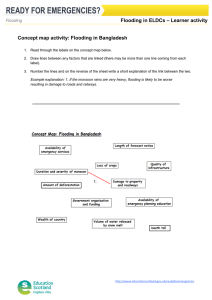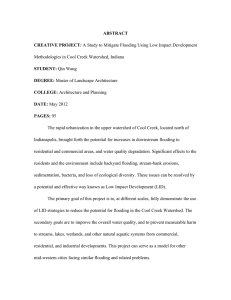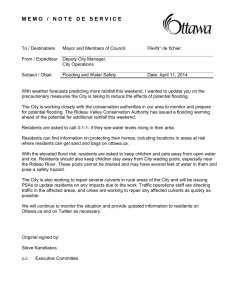US I MEETING MINUTES NFRASTRUCTURE OF CAROLINA, INC.
advertisement

USINFRASTRUCTURE OF CAROLINA, INC. MEETING MINUTES Lyon Court CIP Public Meeting February 15, 2011 I. Welcome and Introductions a) William Harris, project manager with Charlotte-Mecklenburg Storm Water Services (CMSWS), began the meeting by welcoming and thanking the residents for attendance at the meeting. b) William Harris introduced himself and the team members for the project: Kate Labadorf (CMSWS), Amy Bice (CMSWS), David Perry (CMSWS), David Baker (CMSWS), Andrew Martin (USI), Daniel Duymovic (USI) and Ashlie Wood (USI). c) William made sure that all residents had put a sticker on the exhibit that coincided with the resident’s parcel. This was to insure the meeting could be catered to the residents attending the meeting. II. Charlotte’s Storm Water Program a) William explained the nature of the Capital Improvement Project (CIP), and the need for improved storm water systems and maintenance within the project area. b) William informed the residents that the Lyon Court CIP watershed is approximately 300 acres in area and the project limits are generally bounded by The Plaza to the West, Belvedere Avenue to the North, Truman Road and Morningside Drive to the East and McClintock Road to the South. c) William explained that the 311 requests received from the residents had contributed to a higher ranking for the project. That ranking moved the City to work in this watershed. d) William stated that the project’s goals were to update the existing 70 to 80 year old infrastructure, reduce the flooding in structures and streets, increase channel capacity, and reduce erosion. III. Meeting Purpose a) The purpose of this meeting is to discuss existing storm water issues the project team has identified and to receive input from the residents as to what storm water problems they have observed in the neighborhood. b) William informed the residents that there will be two more public meetings. The next public meeting will be in approximately a year and will discuss the proposed improvements the project team has planned. The final meeting will present the 70% design and begin the process of easement acquisitions. IV. Public Input a) William explained that the questionnaires and 311 requests are important because the public input is highly valued and will contribute to the success of the project. b) William expressed that if there are questions or concerns regarding the project during the planning process, they may be posed via email or phone call inquiries. V. Drainage Conditions in the Neighborhood a) Andrew Martin, consulting engineer project manager, began by explaining the drainage conditions in the overall project area. Andrew stated that the neighborhood was built back in the 1930’s and 1940’s, and the design standards at the time the neighborhood was developed were not as strict as they are now. As a result, the analysis is likely to indicate the presence of undersized and outdated storm systems. b) Andrew explained the exhibits and what the symbols on the exhibits stood for. Shaded parcels indicated questionnaire feedback, stars indicated open 311 requests, and hatched structures and streets indicated structural or street flooding. c) Andrew also stated that the team would like feedback on where street flooding occurs in the neighborhood based on the resident’s observations. VI. Q & A Question: Are you using old or new data/information. Response: The data we are using is no more than six months old. Much of the data came from our survey consultant. Once information is received from our survey team, it is used to develop the project hydraulic models. Those models are the basis for the findings related to structural and street flooding. Other data such as land use data does not change as frequently in areas like this neighborhood because it is almost at its full built out condition. Question: What does stream improvements entail, adding rock? Response: There are many options for stream improvements. Some areas require only stabilization, and adding rock is sometimes appropriate. Other stream improvements may involve increasing the capacity of the channel, or restoring natural habitat in and around the channel. However, the Army Corp of Engineers regulates stream improvements, and they typically require more environmentally friendly solutions. The team will have to communicate with the Army Corp of Engineers to determine the best options for the stream improvement. Question: Where does water go during large storm events at the bottom of the system where Morningside meets Commonwealth Avenue? I have seen bad flooding by the power station many times. Are we not just taking more water down the system quicker and adding to the flooding at Morningside and Commonwealth Avenue? Response: That area of the watershed is FEMA regulated. The team will be cognizant of the potential affects upstream improvements could have to downstream sections of the project and will make decisions accordingly. The Briar Creek watershed is significantly larger than the Lyon Ct CIP watershed, and its peak is well after the Lyon Ct CIP peak. A portion of the study already performed has confirmed that the maximum increase in flow from this watershed will not adversely impact the flooding in Briar Creek. Question: Do we account for water in alleys and backyards? Is the alley public right-ofway (R/W)? 2 Response: The project considers water from the entire watershed. Issues originating from a neighbor’s yard can not be addressed by this project. Some alleys are publicly held, but some have been conveyed back to the adjacent property owners. Question: If water is coming from the neighbor’s yard does that get attention? Response: In most cases that would not qualify for service. Only if some of the water is coming from the street would it qualify. Question: Do you address buildings that are being increased in area, such as garages being doubled in size? Is the impervious area calculated for each lot or more generalized? Response: No, building regulations do not typically require stormwater controls for something as small as a residential expansion. The project analysis makes a conservative estimate that generalizes the impervious areas. Question: What do you plan on doing with the water that enters my backyard, piping it out? We have a rain garden, but it needs to be three times bigger. What if the City paid for everyone to have a rain garden or rain barrel. Response: We have not specifically looked at design options yet. Alternatives will be explored as the project progresses. However, typically rain gardens and rain barrels do not provide an adequate level of protection to resolve the flooding issues. In cases where those types of system are explored, they typically become prohibitively large. Comment: David Perry informed the residents that the water that comes from larger infrequent rain events, which rain gardens do not effectively control, is more of the issue we are designing for. Question: How do you plan on reducing the street flooding? Response: There are issues with lack of drainage structures along the existing curb and with undersized culverts. The first issue affects the efficiency of the existing structures to pick up the water coming down the street. With the lack of structures you see water run by the existing structures and to the next inlet. At the low point of the street there is too much water which causes street flooding. This may be fixed by adding additional structures or other means to reduce the amount of water entering the street. Where culverts are undersized, they would most likely be replaced. Comment: Tippah Avenue shows flooding on the map but I have never had a street flooding and I’ve lived there for 20 years. I have seen driveway flooding where the main channel enters the driveway culverts about a half a dozen times on Tippah Avenue. The culvert at Chestnut Avenue detains a lot of storm water. I’m worried that making the culvert larger along with channelizing the upstream water will cause more problems downstream. I would be against doing stream improvements near sections of the stream that contain natural areas. I believe these areas slow down the water. The two red houses at the bottom of Tippah should not be shaded red in my opinion. 3 Response: There are many issues that we look at during the design process. The downstream impacts will be one. The team will look at how much water is stored behind all culverts. The model will consider the effects of removing the detention behind the culverts. We will work closely with The Army Corp of Engineers to determine the most appropriate approach to the stream improvements. The results on the exhibits may reflect fairly infrequent storm events that are considered in the planning process. Question: Why does the Army Corps of Engineers care about the small streams since they are not navigable waters? How did they get involved? Response: The Army Corps of Engineers regulate all jurisdictional streams (Waters of the United States) on a federal level and they are involved in all stream restoration decisions. The Clean Water Act of 1977 is why The Army Corps of Engineers gets involved. Question): I have streams on two sides of my house, who is responsible for cleaning those out? The vines on the trees make it hard to get to the debris in the stream. Response: The hope is that the homeowners would clean out the debris. Normal maintenance and cleaning of the streams is the property owner’s responsibility. You can call 311 if objects are too heavy to remove from the stream or if it is causing a blockage. However, such requests are typically a low priority. The vine issues may be addressed by stream restoration. Question: What about pollutants flowing downstream? Response: This project does not address pollutants from neighboring properties. Question: Does FEMA regulate any of the flooding in this neighborhood? Response: FEMA regulates the floodplain and floodway of Briar Creek, which is where this area drains to. However, FEMA limits their regulation to areas of 1 square mile or greater, and this area has a total area of about a half square mile. So FEMA does not regulate the tributaries in the watershed. VII. Alternative Analysis a) b) First is the planning phase that will last approximately two years. Once 70% plans are prepared, the easement acquisition phase begins, and it lasts between 8-12 months. The bid phase takes about 4-5 months. Then the construction phase between 1-2 years depending on the level of improvements proposed. The total length of the project should be between 5-7 years. The next public meeting will coincide with the completion of the alternative analysis, and will be in approximately 1 year, at the latest. VIII. Summary 4 a) b) c) The existing conditions have been analyzed with various problems being identified as shown on the map. The main goal of the project is to reduce flooding of streets and structures. Resident’s input throughout the project contributes to its success. Andrew explained the hatching on structures and the frequency and percentage of rainfall events shown on the exhibits. Question: Is money an issue for this project? Response: This project is funded by the Charlotte Mecklenburg Storm Water Services. At this time, there are no anticipated issues funding the project through its completion. There has been money set aside for this project each year. This is a high priority project. The meeting was concluded. 5







